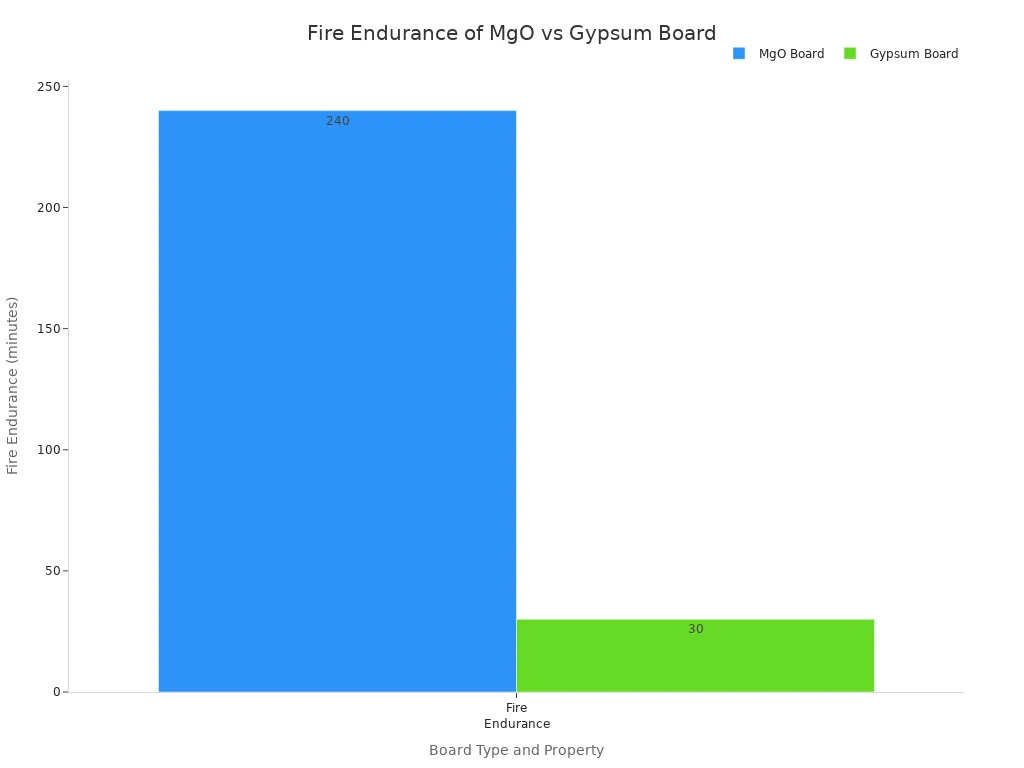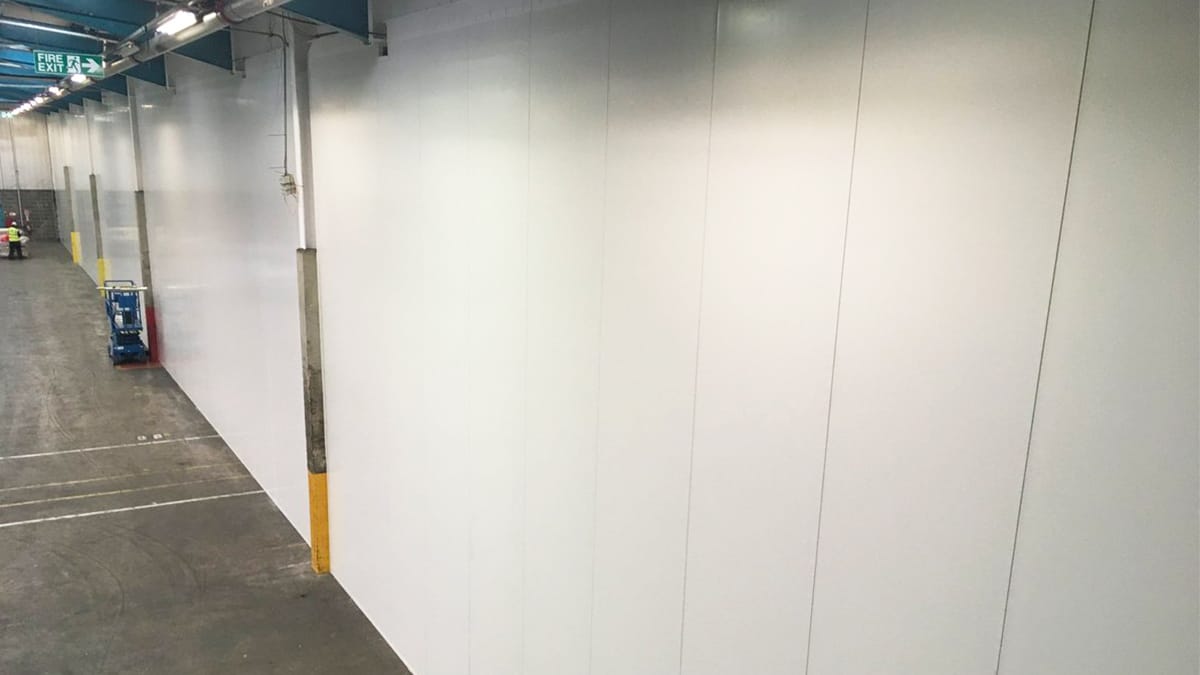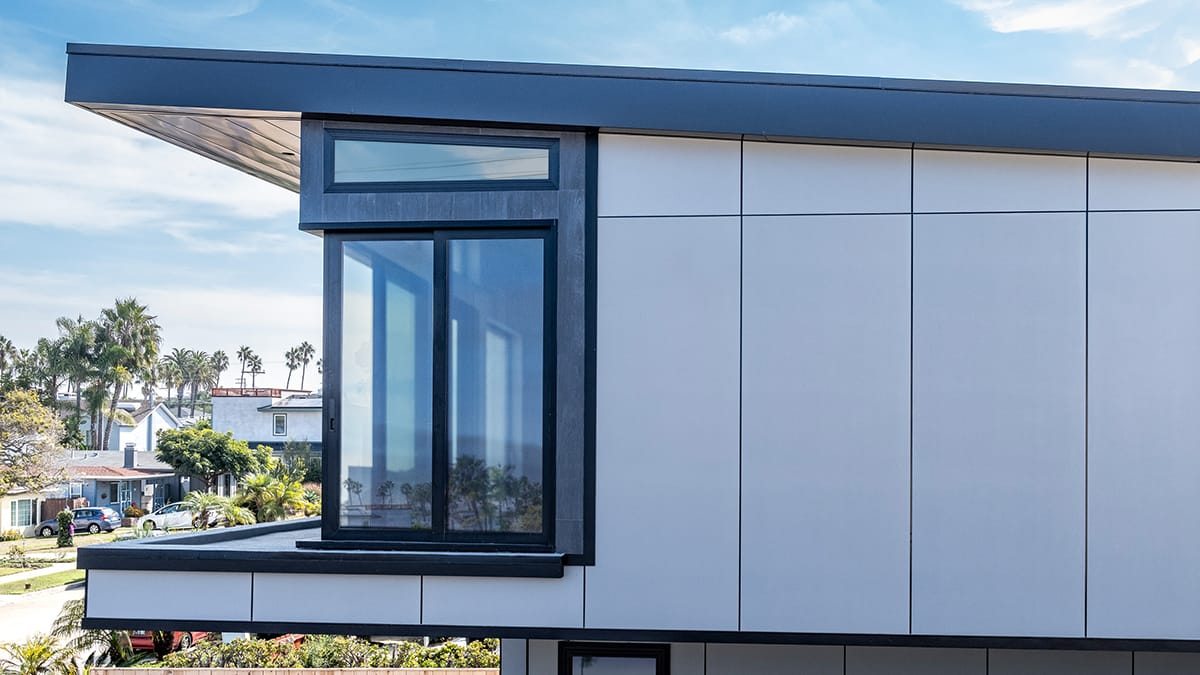
27 Nov What is Magnesium Oxide Wallboard Used for
Table of Contents
- 1 Key Takeaways
- 2 Main Uses of Magnesium Oxide Wallboard
- 3 Benefits of Magnesium Oxide Board and Panels
- 4 Practical Considerations for MGO Board
- 5 Uses of Magnesium Wall Boards in Modern Construction
- 6 FAQ
- 6.1 What makes magnesium oxide wallboard different from regular drywall?
- 6.2 Can you paint or finish magnesium oxide wallboard?
- 6.3 Is magnesium oxide wallboard safe for people with allergies?
- 6.4 How do you cut and install magnesium oxide wallboard?
- 6.5 Where should you use magnesium oxide wallboard in your home?
Magnesium oxide wallboard also know as MgO wallboard is a durable, fire-resistant, and versatile construction material used as an alternative to fiber cement board, drywall or plywood. It’s made from magnesium oxide cement mixed with reinforcing materials like glass fibers and cellulose fibers, and is known for its strength, water resistance, and resistance to mold, insects, and fire.
In this article, I will guide you through the most important points about applying MgO Wallboards.
Application Type | Description |
|---|---|
Many homes use it because people want strong and safe walls. It is good for the planet and lasts long. | |
Commercial Buildings | It is important for stopping fires and lasting a long time. Offices, stores, and hotels use it for safety and looks. |
Mgo gives you what you need for safe, strong, and earth-friendly places.
Key Takeaways
Magnesium oxide wallboard does not burn or get damaged by water. This makes it good for safe buildings in homes and businesses.
This material is strong and does not grow mold. It lasts a long time in wet places like bathrooms and kitchens.
Using magnesium oxide wallboard helps the environment. It makes less CO2 when it is made.
You can install it easily with normal tools. You need to use the right screws and leave space between boards for best results.
It can cost more than regular drywall. But it is safer, stronger, and better for the planet. This makes magnesium oxide wallboard a smart choice.
Main Uses of Magnesium Oxide Wallboard
 Interior Walls and Ceilings
Interior Walls and Ceilings
Magnesium oxide wallboard is used for many things inside. It is great for walls and ceilings in homes and buildings. This board is safer and stronger than regular drywall. It does not burn, so it helps protect you from fire. It also does not soak up water. Mold and mildew cannot grow on it. That is why it works well in bathrooms, kitchens, and basements.
Here is a table that shows how it is different from gypsum drywall:
Feature | Magnesium Oxide Wallboard | Gypsum Drywall |
|---|---|---|
Fire Resistance | Non-combustible, zero flame spread rating | Combustible, can contribute to fire |
Moisture Resistance | Does not absorb water, mold-proof | Absorbs water, can grow mold |
Durability | More impact-resistant, handles weight | Less durable, tears easily |
Installation Ease | Cut with standard tools, easy to install | Some types need special tools |
You can put magnesium wall board in places with lots of moisture. It is good for schools, hospitals, and busy homes. You do not need special tools to cut it. You can use the same tools as for drywall.
Tip: Pick mgo if you want walls that stay strong and do not get mold.
Sub-Flooring and Underlayment
Mgo boards make floors strong and steady. You can put them under tile, wood, or carpet. They do not soak up water, so they do not swell or bend. Even in wet places like bathrooms, these boards stay strong.
Here are some reasons to use mgo for floors:
It is strong and can hold heavy things.
It does not burn, so it is safer.
It keeps out water, mold, and mildew.
It is light, so it is easy to move and put in.
It is good for the earth.
Magnesium oxide wallboard stays strong even if it bends a little. It does not fall apart when it gets wet. Your floors will last longer and stay safe.
Exterior Sheathing and Siding
You can use mgo boards outside as siding or sheathing. They keep out rain, wind, and fire. These boards do not bend, swell, or rot in bad weather. They are tough, so your walls stay strong for a long time.
Attribute | Description |
|---|---|
Moisture Resistance | High resistance, repels mold and mildew, prevents warping or rot |
Impact Resistance | Excellent strength, increases lifespan of structures |
Fire Resistance | Resists fire, enhances safety and longevity |
Environmental Resistance | Works in extreme cold or heat, suitable for many climates |
Longevity | Durable, increases lifespan of homes and buildings |
If you live where there are fires or lots of rain, mgo siding helps protect your home. It also keeps bugs away. It works in hot and cold places.
Trim, Fascia, and Soffits
You can use mgo boards for trim, fascia, and soffits. These parts get hit by bad weather, but mgo does not give up. It does not soak up water, so it will not swell or rot. It also keeps out fire, mold, and bugs.
Use mgo for soffits under the roof to keep your home safe.
Put it as fascia for a neat look and more roof edge protection.
Pick mgo for trim because it is light, tough, and keeps out termites.
Magnesium oxide wallboard stays strong for many years. It does not scratch or dent easily. You can count on it to last, even in rough weather.
Note: Mgo boards help you build safer and cleaner places that last a long time.
Benefits of Magnesium Oxide Board and Panels
 Fire and Water Resistance
Fire and Water Resistance
You want your building to be safe from fire and water. Magnesium oxide wallboard gives very strong fire protection. It does not burn or help fire spread. You can use it in places where safety is important, like hospitals and schools. Tests show magnesium wall board stays strong even in high heat. Check this table to see how it compares to gypsum board:
Property | MgO Board | Gypsum Board |
|---|---|---|
Fire Resistance Rating | A1 Non-Combustible (highest class) | Fire-resistant up to 1 hour |
Fire Endurance | Up to 4 hours | 30-60 minutes |

Mgo boards also give strong moisture protection. They do not swell or crack when wet. Mold and mildew cannot grow on them. This helps stop damage in bathrooms, kitchens, and basements. These boards pass tough tests like ASTM E119 and EN 13501-1 for fire safety.
Durability and Strength
You want a building material that lasts a long time. Magnesium oxide board is strong and durable for many years. It can handle bumps, heavy things, and daily use. Mgo boards keep out mold, mildew, and bugs. You will not need to fix them often. Drywall can dent and crack, but mgo stays tough. Here is what tests show:
Findings | Description |
|---|---|
Load-bearing capacity | Mgo panels hold heavy things and do not bend. |
Failure modes | Panels only break after cracks, showing strong bonding. |
Maintenance | Needs little care, drywall needs more repairs. |
Magnesium wall boards work well in busy places like schools, offices, and hospitals. Their strength and durability help walls and floors last longer.
Eco-Friendly Properties
If you want to build in a green way, magnesium oxide board is a good choice. It is better for the planet and lowers your carbon footprint. When made, these boards absorb CO2, which helps the earth. They use less energy to make than gypsum boards. For every ton made, magnesium oxide gives off only 340 kg of CO2, while gypsum gives off 740 kg. You help the planet and support green building when you pick mgo.
Certification | Details |
|---|---|
CE | Meets safety and health rules |
ISO | Makes sure boards are made with good quality |
INTERTEK | Shows safety and performance |
ASTM E84 | Fire safety standard |
EN 13501 | Fire classification |
UL 723 | Fire safety standard |
Magnesium board helps both the environment and your building. These boards let you build safe, strong, and green spaces.
Practical Considerations for MGO Board
Installation and Compatibility
When you put in mgo, you must follow some steps. This helps you do a good job and avoid mistakes. If you use wood frames, leave a 1/8-inch space between boards. For steel frames, leave a 1/16-inch space. Always pick screws that do not rust, like 316-stainless steel. Drill small holes before putting in the screws. Put screws every 12 inches on the edges and every 16 inches in the middle. Make sure screws are even with the board, but do not make them too tight.
Tip: Put the panels in a staggered way and keep the right space between boards. This lets the boards move and stops cracks.
Some builders think cutting mgo board is hard because it is thick. Regular utility knives might not work well. You may need special tools to cut it. Also, normal fasteners may not hold the board tight, so always use screws made for mgo.
Cost and Value
You may see that magnesium oxide board costs more than gypsum board. Here is a table with the usual prices:
Material | |
|---|---|
Magnesium Oxide Board | $1.50 – $2.50 |
Gypsum Board | $0.50 – $1.00 |
Even though mgo board is more expensive, it is better at stopping fire, water, and damage. More builders want mgo because it is safer and better for the earth. When you pick a supplier, choose one with good products and green practices. This helps you get the best value for your building.
Maintenance and Longevity
To keep your mgo board nice, check it often for cracks or mold. If you see damage, fix or change that part right away. Clean the board with a soft cloth or sponge and gentle soap. Do not use strong chemicals or rough tools. Make sure your room has good airflow to stop water from building up, which can cause mold.
Mgo is known for being strong. It stays tough even in wet places and does not lose fire safety over time. You will not need to fix or change it as much as other boards. This makes it a smart pick for homes and businesses that want strong, green buildings.
Note: Some bad things about magnesium oxide boards are that you need special tools to cut them and they cost more than gypsum. But the good things, like being strong, safe from fire, and safe from water, are often worth it.
Uses of Magnesium Wall Boards in Modern Construction
 Versatility Across Building Types
Versatility Across Building Types
Magnesium wall boards can be used in many buildings. They work in homes, offices, schools, and hospitals. These boards are good where fire and water are problems. Builders use mgo in bathrooms, kitchens, and basements. This is because it keeps water out and stops mold. Mgo is also used in modular buildings. These buildings go up fast and need strong materials.
Offices, malls, and hotels use magnesium wall boards for fire safety and strength.
Bathrooms and basements need mgo to stop water and mold.
Modular buildings use mgo because it is quick to install and lasts long.
Magnesium wall boards help make safe and healthy rooms. They stop mold and mildew from growing. You get walls that stay strong for a long time.
Here is a table that shows how builders use magnesium wall boards:
Application Type | Description | Source Link |
|---|---|---|
Residential | Used in homes for fire safety and mold prevention. Projects in Europe and Australia show both benefits and issues. | |
Commercial | Applied in offices, schools, and hospitals for their strength and safety. They help meet building regulations. | |
Specific Case Study | A school used magnesium oxide panels to enhance fire safety and improve indoor air quality. |
You can see mgo panels in homes and busy buildings. They keep out mold and mildew and are very strong.
Noncombustible and Structural Applications
You want building materials that keep you safe. Magnesium wall boards do not burn. They meet fire safety rules like ASTM E119 and ASTM E136. These boards help stop fire from spreading. Builders use mgo in tall buildings, apartments, stairs, and shared spaces. You also see them in classrooms, gyms, and hospitals.
MagPanel® is used in busy places that need strong walls.
Schools use magnesium wall boards for fire safety and to stop mold.
Hospitals use mgo because it is strong and easy to clean.
Magnesium wall boards give you walls that do not burn. They keep out mold and mildew and stay strong in busy places. You get safe and long-lasting rooms for work, school, and home.
Tip: Pick magnesium wall boards if you want strong, fire-safe, and mold-free walls in any building.
You can pick magnesium oxide wallboard for many building jobs. It works for new buildings and fixing old ones. This board is good at stopping fire. It also keeps mold from growing. Your walls and ceilings will last longer with it. Builders like it because it keeps out water and mold, even in wet rooms. It is light, so it is easy to put up. Magnesium oxide wallboard is also good for the planet. It helps you build in a green way.
Main benefits:
Blocks mold and mildew
Stays strong in busy places
Feature | Benefit |
|---|---|
Durability | Stays strong when used every day |
Mold Resistance | Stops mold in wet rooms |
Fire Resistance | Helps keep your home and family safe |
You should ask a building expert how to use magnesium wallboard in your project.
FAQ
What makes magnesium oxide wallboard different from regular drywall?
Magnesium oxide wallboard keeps out fire and water better. It will not burn or soak up water. Mold and mildew cannot grow on it. You can use it where safety is very important.
Can you paint or finish magnesium oxide wallboard?
You can paint this wallboard. First, put on primer for best results. You can also use wallpaper or tiles. Always read the maker’s instructions before finishing.
Is magnesium oxide wallboard safe for people with allergies?
This wallboard helps people with allergies stay safe. It does not let mold or mildew grow. The air inside stays cleaner. People with allergies can breathe easier.
How do you cut and install magnesium oxide wallboard?
You can cut it with saws or snap knives. Always wear safety gear when working. Use screws that do not rust to put it up. Leave small spaces between boards so they can move.
Where should you use magnesium oxide wallboard in your home?
Use it in bathrooms, kitchens, basements, and laundry rooms. It works well in places with lots of water or fire risk. You get strong and safe walls and ceilings.

 Interior Walls and Ceilings
Interior Walls and Ceilings Fire and Water Resistance
Fire and Water Resistance Versatility Across Building Types
Versatility Across Building Types